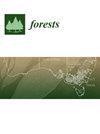Chemical and Microbial Differences of Root and Rhizosphere Soil among Different Provenances of Fokienia hodginsii
IF 2.4
2区 农林科学
Q1 FORESTRY
引用次数: 0
Abstract
Aims: Fokienia hodginsii is a threatened conifer tree species, known as the dominant nursery-grown species capable of colonizing the challenging woodland environments in southern China due to its strong root penetrating ability. The ecological phenotype of Fokienia hodginsii is not well documented during its breeding process, which limits the potential planting area and its ecological function. This study aims to understand how Fokienia hodginsii associates with microbes to conduct its key ecological function and provide a theoretical basis for further improving the forest nursery management of Fokienia hodginsii. Methods: This study explored the ecological traits of 11 main Fokienia hodginsii provenances in a homogeneous garden experiment by analyzing their nutrient utilization strategies and associated microbial features in the rhizosphere soil and roots. Results: The study found that the paramount difference in the rhizosphere soil among provenances is in Ca and Fe content. Some microbial communities, namely Crenarchaeota, Verrucomicrobiota, and Desulfobacterota, were positively correlated with the amounts of the soil nutrient elements, whereas Abditibacteriota and Dependentiae were negatively correlated. The abundance of N- and Fe-related bacteria in the Fu Jian Chang Ting (FJCT) provenance was significantly higher than that in other provenances, while the C-, P-, K-, and Mg-related fungal communities, respectively, had higher abundances in the FJCT, Fu Jian Long Yan (FJLY), Fu Jian Gu Tian (FJGT), and Fu Jian Xian You (FJXY) provenances than the others. The impacts of the Gui Zhou Li Ping (GZLP), Hu Nan Dao Xian (HNDX), Jiang Xi Shang Yao (JXSY), and Guang Dong Shi Xing (GDSX) provenances on the rhizosphere soil are similar, but the differences in nutrient utilization arise from the plant itself. Conversely, the root nutrient contents of the FJCT, Fu Jian You Xi (FJYX), Fu Jian An Xi (FJAX), FJLY, Fu Jian De Hua (FJDH), FJGT, and FJXY provenances are highly correlated with soil nutrient features. Conclusions: For the native provenances, their economic traits are better than the exotic provenances. The native provenances are more sensitive to local soil conditions, so they should benefit more from human interventions, rendering them more suitable for artificial cultivation. The growth of the exotic provenances is less affected by the soil environment, making them better suited for the ecological transformation of forest stands and soil improvement.不同原产地霍奇金藻根部和根瘤土壤的化学和微生物差异
目的:红豆杉(Fokienia hodginsii)是一种濒危针叶树种,因其强大的根系穿透能力而被称为能够在中国南方具有挑战性的林地环境中定居的主要苗圃培育树种。在其育种过程中,霍金树的生态表型并没有得到很好的记录,这限制了其潜在的种植面积及其生态功能。本研究旨在了解霍奇金藻如何与微生物结合以发挥其关键生态功能,为进一步改善霍奇金藻的林木育苗管理提供理论依据。研究方法本研究在同质园实验中,通过分析11个主要霍奇金藻产地的养分利用策略以及根圈土壤和根部的相关微生物特征,探讨了霍奇金藻的生态学特性。研究结果研究发现,不同产地根圈土壤中钙和铁含量的差异最大。一些微生物群落,即 Crenarchaeota、Verrucomicrobiota 和 Desulfobacterota 与土壤养分元素的含量呈正相关,而 Abditibacteriota 和 Dependentiae 则呈负相关。与 N 和 Fe 相关的细菌在藤县长汀(FJCT)产地的丰度明显高于其他产地,而与 C、P、K 和 Mg 相关的真菌群落在藤县长汀(FJCT)、藤县龙岩(FJLY)、藤县古田(FJGT)和藤县仙游(FJXY)产地的丰度分别高于其他产地。桂州黎平(GZLP)、湖南道县(HNDX)、江西上饶(JXSY)和广东始兴(GDSX)产地对根圈土壤的影响相似,但养分利用率的差异来自植物本身。相反,FJCT、福剑尤溪、福剑安溪、FJLY、福剑德化、FJGT 和 FJXY 产地根系养分含量与土壤养分特征高度相关。结论本地品种的经济性状优于外来品种。本地品种对当地土壤条件更敏感,因此它们应更多地受益于人为干预,更适合人工栽培。外来品种的生长受土壤环境的影响较小,因此更适合林分生态改造和土壤改良。
本文章由计算机程序翻译,如有差异,请以英文原文为准。
求助全文
约1分钟内获得全文
求助全文
来源期刊

Forests
FORESTRY-
CiteScore
4.40
自引率
17.20%
发文量
1823
审稿时长
19.02 days
期刊介绍:
Forests (ISSN 1999-4907) is an international and cross-disciplinary scholarly journal of forestry and forest ecology. It publishes research papers, short communications and review papers. There is no restriction on the length of the papers. Our aim is to encourage scientists to publish their experimental and theoretical research in as much detail as possible. Full experimental and/or methodical details must be provided for research articles.
 求助内容:
求助内容: 应助结果提醒方式:
应助结果提醒方式:


